The post How to build an automated warehouse system: which new technologies do you need and why? appeared first on 6 River Systems.
]]>Let’s take a look at the new technologies you need — and why you need them – when building an automated warehouse system:
- Interoperability between warehouse systems and software
- Cloud computing and storage
- Real-time tracking mechanisms
- Collaborative mobile robots
- Access to on-demand warehousing
- Data analytics and artificial intelligence
- Cartonization software
- Drones
- Automated forklifts
- Older automation technologies
- How does automation affect the physical layout of a warehouse?
- How much does it cost to automate a warehouse?
- Additional Resources on Warehouse Automation Systems
Interoperability between warehouse systems and software

First and foremost, interoperability is key. Your warehouse systems and software need to be able to share data between them, but those systems are not all the same and may have different data formats. Interoperability solves this challenge by allowing applications to seamlessly share data, such as inventory data, shipping information and purchase orders. Without interoperability, data remains siloed and you can’t benefit from a comprehensive, bird’s-eye view of your warehouse operations.
Application programming interfaces (APIs) are the most common technology driving interoperability, not only in the warehouse but also in other industries, such as healthcare. APIs enable applications to collect data from disparate warehouse information systems, supporting integration and eliminating data silos. Integrating data from disparate sources also supports data analytics and artificial intelligence solutions, which we’ll discuss later in this guide.
Cloud computing and storage

When it comes to automating your warehouse systems, cloud computing and storage offers several benefits, including reduced infrastructure and maintenance costs. Rather than setting up and maintaining an on-site data center, cloud computing provides a more scalable solution while reducing the need for an in-house IT department. Cloud computing also makes system integration possible, meaning you can integrate multiple systems for ease of access.
As warehouses generate and collect more data from various information systems and from the supply chain, cloud computing is more necessary for the modern warehouse than ever. Cloud computing not only makes system integration easier, but it also supports collaboration between supply chain partners.
Real-time tracking mechanisms

Modern warehouses use real-time tracking mechanisms like RFID, which use radio waves to transmit data between tags or labels and computer and information systems. The benefits include increased visibility into your inventory throughout the supply chain, including shipping and delivery, ensuring that the right items get to the right customers at the right time.
Real-time tracking mechanisms like RFID improve stock and demand generation visibility, allowing warehouses to maintain leaner inventory and reduce overhead costs. Some innovators are experimenting with pairing RFID with drones to automate delivery processes.
Collaborative mobile robots
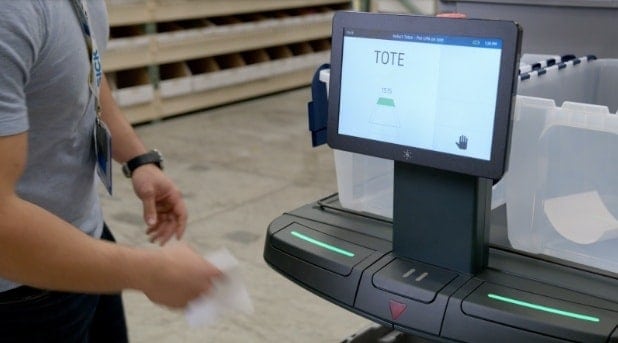
In 2016, CBRE Group released a report exploring the impact of robotics and automation, autonomous trucks and 3-D printing on supply chains, predicting that these three technologies would have a transformational impact on distribution over the next decade. Adoption of automation in warehouses and on highways is driven by the growth of faster fulfillment cycles and e-commerce, according to CBRE, noting that these three technologies are on track to achieve widespread use by 2025.
One often-cited concern is the impact of automation on the workforce, but automation doesn’t necessarily replace the work of human workers. Collaborative mobile robots, for example, enhance the work of human warehouse associates by guiding them through the picking process to increase productivity and accuracy.
Another benefit of collaborative mobile robots to automated warehouse systems is rapid implementation. With a solution like 6 River Systems, you can go live in weeks instead of the months necessary for implementing traditional automation solutions. With cloud-based algorithms that manage work in real-time, 6 River Systems reduces steps between tasks and eliminates the long walk.
Access to on-demand warehousing

On-demand warehousing gives companies access to additional warehouse space that’s used, rented or leased on a temporary basis to accommodate short-term capacity needs. Warehouse matching services like Flexe connect companies in need of warehouse space with those that have space available, serving as a middle-man of sorts to facilitate share-economy warehousing.
The benefits of on-demand warehousing are obvious: it allows warehouses to adapt more readily to shifts in market demand, while reducing or eliminating the need to invest in additional infrastructure that would otherwise go unused for part of the year. Conversely, the on-demand warehousing model also enables warehouses who have unused infrastructure to monetize that space and reduce overhead costs.
Data analytics and artificial intelligence
![]()
Collecting raw data with real-time tracking and other tools is useful, but data analytics and artificial intelligence (AI) are the solutions that turn raw data into actionable insights. Data analytics and AI tools enable operators and managers to make timely data-driven decisions, responding to existing information in real-time and even taking proactive measures in response to predictive analytics data.
As mentioned previously, interoperability made possible with APIs or other integration tools eliminates data silos. In turn, data analytics and AI solutions derive insights based on a more comprehensive data set to support decision-making with more context (input from the various warehouse information systems rather than input from a single solution). For example, it’s better to make decisions about ordering inventory based on historical order data combined with supplier data and market trends data than it is to make the same decision based on historical order data alone.
Modern warehouses use technologies like data analytics and AI to optimize picking routes, for inventory and capacity planning and more. Other technologies have built-in AI solutions, such as 6 River Systems’ Chuck, which uses AI and machine learning to prioritize tasks based on work assignments and the status of the warehouse floor. Chuck optimizes picking routes in real-time and even spots risks to keep your associates on-task and maximize productivity.
The benefits of data analytics and AI aren’t just for warehouses. Top logistics companies, for example, pair real-time vehicle tracking with AI to streamline fleet planning and improve delivery speed by re-routing vehicles in real-time to avoid potential weather or traffic delays.
Cartonization software

It’s not always easy to estimate the correct carton size, even for seasoned packing associates. When an associate chooses the wrong carton size, they end up back-tracking and repeating tasks for the same order. If the carton isn’t too small for the order, associates may pack the order in the too-large carton anyway, which isn’t an efficient use of resources.
Cartonization software calculates the ideal carton size for each order based on SKU dimensions, product weight data and other factors. That means associates don’t need to guess the right carton size, eliminating wasteful spend on too-large shipping boxes and subsequent shipping costs and the labor spent repacking orders. Cartonization software supports lean, single-touch pick and pack processes, especially when it’s paired with an efficient picking technology like collaborative mobile robots.
Drones

While they’re not yet considered an essential technology for an automated warehouse system, there’s a lot of hopeful speculation about the role of drones in the future warehouse. Some companies are already experimenting with drones for inventory management and delivery. For example, drones can speed up inventory counts by scanning barcodes and recording item location information in the warehouse management system up to 50 times faster than manual data capture. According to The Future Warehouse, any discrepancies identified by the drone stock counting process are checked manually by human workers to confirm and address discrepancies or reconcile errors.
Walmart tested an aerial inventory technology, powered by drones, in 2016. According to a report from The New York Times, the trial included “sensor-equipped drones [that] flew in the aisles of a distribution center and alerted management to products that were close to being out of stock or were not in their assigned slot.”
Another example is Amazon’s Prime Air, “a future delivery system from Amazon designed to safely get packages to customers in 30 minutes or less using unmanned aerial vehicles, also called drones.” While it’s still in the development phase, it’s no surprise that the largest online retailer is an early pioneer of drone technology in the supply chain. That said, Amazon isn’t the first company to get FAA approval for drone delivery; as Recode reports, that achievement goes to Alphabet’s Wing Aviation program, an offshoot of Google. A use case still in its infancy, the use of drones for delivery could have big implications for neighborhood stores, not to mention UPS, FedEx and the U.S. Postal Service.
Automated forklifts

While they’re not among the newest warehouse automation technologies, the use of automated forklifts has grown in recent years. Like collaborative mobile robots, automated forklifts don’t require investing in new infrastructure. In particular, newer models don’t require special floor tape or other fixed infrastructure to direct them throughout the warehouse. For the most part, they can operate in the same routes used by your human workers but handle tasks that would typically involve long travel times for stock picking or put-away tasks.
Typically equipped with sensors that detect activity in their path, automated forklifts can avoid collisions with other vehicles or human associates. As many forklift accidents are attributed to inadequate training or human error, automated forklifts can improve safety assuming sensors and other safety mechanisms are functioning properly. Thanks to these same sensors, automated forklifts offer more precise and secure load handling, resulting in reduced product damage from handling. They can also improve productivity by handling time-consuming and repetitive tasks, freeing up your associates up for more value-added tasks.
Older automation technologies

Automation technologies as a whole aren’t new; warehouses have been embracing them for years. As such, there are older automation technologies that are being replaced by flexible collaborative picking robots, such as:
- Automated Storage and Retrieval Systems (AS/RS) — Because they can operate with smaller warehouse aisles and taller racks, AS/RS improve the use of warehouse floor space and improve cube utilization. However, they’re expensive to install and often require extensive customization, as well as substantial infrastructure investments. Additionally, AS/RS maintenance requirements are greater than many other warehouse automation solutions.
- Pick-to-light and put-to-light systems — Using lights or LED displays, pick-to-light and put-to-light systems point associates to the correct location for items. While these systems can improve accuracy, they don’t get rid of long walks in the warehouse and don’t offer much guidance to associates beyond pinpointing the right locations for stock picking and putting. These systems require confirmation when items are picked, or for stock putting, associates manually distribute items to their proper locations and then turn off the light when the task is complete.
- Voice tasking technology — With voice tasking technology, also known as voice picking technology, warehouse associates wear headsets to communicate with the warehouse management system, which is equipped with speech recognition and synthesis capabilities. Associates can speak the last few digits of an item’s SKU to confirm that they’re picking the right item. This system allows associates to work with both hands free and without referring to written orders or instructions, although wearing a headset can interfere with an associate’s ability to hear forklifts and other vehicles approaching. Voice tasking technology also leaves room for human error.
- Automatic guided vehicles (AGVs) — AGVs navigate a warehouse using wires attached to the floor with magnetic strips, laser navigation and vision navigation aided by live video streams from cameras placed throughout a warehouse facility. They require little human intervention to work and may be used in applications that aren’t ideal for human workers, such as extreme temperatures. AGVs can be costly to implement, however, and they’re not as flexible, limited to set routes and requiring changes to the warehouse infrastructure. They may also require more maintenance compared to newer automation solutions.
- Automated sortation systems — There are a variety of types of automated sortation systems, designed to sort items of varying sizes and quantities. The biggest downside to these systems is that they require significant infrastructure investments. They’re also fixed in place and not as flexible compared to other automation technologies. For more on sortation, read “How Sortation Boosts Your Competitive Advantage.”
How does automation affect the physical layout of a warehouse?
Whether you’re overhauling parts of your manual operations or leveraging a fully integrated solution, warehouse automation delivers several competitive advantages. This includes:
- better lead-times
- product security and condition
- improved order accuracy
- reduced operating costs
- reduced facility size
- efficient utilization of warehouse space
- better productivity
- improved ergonomics
However, the effective utilization of warehouse floor space is one of the most significant but overlooked benefits of warehouse automation.
The extent by which the layout of a warehouse changes during the deployment of automation systems depends on the kind of system being deployed. Most automated systems eliminate the need for wide aisles — a must when human operators need to travel through the warehouse to handle order fulfillment activities.
This is because robots can efficiently travel through less spacious environments and better handle product retrieval and storage in congested warehouses. Automation enables businesses to reduce the footprint of their warehouse (and other associated costs) while increasing the efficiency of order fulfillment activities.
In modern distribution operations, warehouse control software, AGVs, AMRs and ASRS all work together to optimize replenishment, storage and order fulfillment activities…at a fraction of the cost and supervisory headaches required by manual labor. With automated storage and retrieval systems, businesses can design their warehouse to maximize the use of space, both vertically and horizontally.
If you’re concerned about the cost and hassle of redesigning your warehouse space for automated systems, you can invest in collaborative mobile robots. Cobots do not require extensive changes to your warehouse layout or operating procedures.
How much does it cost to automate a warehouse?
According to F. Curtis Barry & Company, labor costs account for 60 to 65% of warehouses’ fulfillment costs, not including shipping. Here’s how you calculate fulfillment costs.
As of March 2018, estimates show that the labor expenses for the average warehouse (with 100 non-supervisory employees) cost at least $3.7 million. This excludes health insurance, benefits, disability insurance, vacations, paid leaves, etc.
With this in mind, warehouse automation can be a real game-changer for businesses looking to improve profit margins and reduce operational expenses by minimizing labor costs.
The global warehouse automation market is expected to reach $22.4 billion by the end of 2021. This points to the massive adoption of collaborative robots and other associated warehouse automation technologies by businesses and distribution operations. In particular, the AMR/AGV market is expected to reach $4 billion by 2025. AMRs are highly sought after by e-commerce operations and small to medium warehouses due to their lower cost, ease of deployment and rapid ROI.
Whether it’s physical or process-based, the cost of deploying warehouse automation depends on how complex and far-reaching it is. A holistic, sophisticated solution that delivers end-to-end automation will require more equipment and robust software than one that automates certain parts of the order fulfillment process.
The level of automation you desire determines the type of software and hardware solution you need to deploy. The size of the distribution/warehousing operation is also a major factor. All this contributes to the cost of automating the warehouse.
Here are some rough estimates of the cost of automating the average warehouse:
- Fully automated solution — at least $25 million
- Semi-automated solution — between $5 – $15 million
- Mechanized solution — $1 – $5 million
- An automated solution that improves manual picking activities — between $500,000 and $1 million
Due to the cost implications, jumping on the warehouse automation bandwagon is no easy decision. However, there are several tactical, strategic and economic benefits to automating your warehouse operations (and by extension, the supply chain).
You can test the waters by investing in flexible, cost-effective and highly adaptable warehouse automation tools. Moving to an automated warehouse is easier today than ever before, thanks to flexible, easier-to-implement automation solutions like collaborative mobile robots. If you’re building an automated warehouse system, the solutions discussed in this guide provide a solid foundation for efficient operations.
Additional Resources on Warehouse Automation Systems
Visit the following resources to learn more about new warehouse automation technologies and how today’s warehouses are leveraging automation solutions to improve operational performance:
- Labor Crunch, E-Commerce Competition Drive Warehouse Automation Trends
- Warehouse Automation Is The New Battleground For Retailers
- 14 Supply Chain Trends for 2020: New Predictions To Watch Out For
- Warehouse Automation Market Off to a Strong Start in 2020
- Warehouse Automation: The Next Generation
- Warehouse automation: five emerging trends
- 2020 Warehouse/DC Equipment Survey: Making the right moves to offset pressures
- 2019 Warehouse/DC Operations Survey: Tight labor and space pressure drives a technology surge
- How Warehouse Automation is Enabling the E-Commerce Explosion
- The Case for Warehouse Automation
- 2020: Future of Manufacturing Technology
The post How to build an automated warehouse system: which new technologies do you need and why? appeared first on 6 River Systems.
]]>The post What is a 3PL system? appeared first on 6 River Systems.
]]>Definition of 3PL 
What is a 3PL service? Companies that outsource all or part of their distribution and fulfillment activities typically outsource these functions to 3PLs. Often, 3PLs don’t have ownership in the inventory. Instead, they handle various business functions on behalf of other companies on a fee-for-service or contractual basis. 3PLs can handle everything from receiving new inventory from manufacturers to shipping products to end consumers and everything in between. Some 3PLs even handle retail distribution and returns. The specific services offered by 3PLs may differ from company to company, and 3PL clients typically outsource a customized set of services based on their unique needs. For example, a company may already have an on-site warehouse but outsources order fulfillment and distribution services to a 3PL rather than expanding its in-house capabilities.
3PL use is prevalent (and growing). A report by Armstrong & Associates found that 86% of Fortune 500 companies and 96% of Fortune 100 companies utilized 3PLs in 2013. In 2017, Armstrong & Associates found that 90% of domestic Fortune 500 companies use 3PL providers, compared to just 46% in 2001.
Types of 3PL services offered
3PLs offer a variety of services, but not all 3PLs offer the same services and functions and some 3PLs specialize in one or two areas. Most 3PLs focus on one of these functional areas:
- Transportation: 3PLs focused on transportation handle inventory shipments between manufacturers and your warehouse or your between your company and your buyers.
- Warehousing and Distribution: The most common type of 3PL that companies use, handling functions such as storage, fulfillment, pick and pack, shipping and returns.
- Financial and Information: Typically used by larger companies, these 3PLs optimize your company’s logistics network by providing services ranging from accounting and cost control to freight auditing, inventory tracking and management and similar functions.
Some larger 3PLs offer services in all of the above functional areas for their clients.
How 3PLs work 
Companies that produce or manufacture products, such as books, sports gear or other goods, but don’t want to handle order fulfillment and shipment in-house often outsource these tasks to 3PLs. A fulfillment center that processes orders and a trucking company that handles logistics on behalf of clients are both considered 3PLs, but a single 3PL provider may also handle multiple processes, such as packaging, warehousing, fulfillment and distribution.
3PLs sometimes outsource services they offer to other companies, acting as a 4PL provider. The distinction is that true 3PLs provide services directly to clients, while 4PLs may offer some services directly but outsource other services to other 3PL providers. In some cases, a 4PL acts as a manager, outsourcing all needed services to one or more 3PLs on behalf of clients without actually providing any services directly (aside from management). 4PLs may outsource any of the activities offered by 3PLs, including:
- Transportation and logistics, such as trucking services to deliver goods to retailers or end consumers.
- Warehousing and distribution, such as storage, packaging and order fulfillment services.
- Financial and information services, such as accounting services or inventory management.
Benefits and disadvantages of 3PLs
One of the main advantages of using 3PL services is that 3PLs are typically experts in their area. A company that focuses exclusively on handling warehousing and distribution functions on behalf of multiple clients is more experienced and knowledgeable on best practices and current strategies compared to, for instance, a book company that has never managed order fulfillment or distribution processes. For companies that lack expertise in these areas, outsourcing to a 3PL can be far more effective than setting up an in-house team and starting from scratch.
3PLs are also useful for meeting global fulfillment needs. Some 3PLs have a broader footprint, with physical locations and distribution centers around the world. Using a 3PL with a global presence means maintaining inventory closer to your buyers, plus you can tap into the 3PL’s expertise in handling customs functions and complying with international regulations.
Outsourcing to a 3PL also means lower overhead costs compared to in-house order fulfillment, as there’s no need for your company to invest in warehouse facilities and distribution centers, trucking resources and other assets. Due to a 3PL’s expertise, you’ll benefit from better performance (and thus happier customers). Plus, it’s easier to scale your operations when using a 3PL compared to scaling the same functions in-house, because you don’t need to invest in a larger warehouse facility or hire additional staff to manage these processes. Instead, your 3PL provider dedicates more resources to meet your needs.
That’s not to say that there aren’t some disadvantages to using a 3PL service provider. You’ll have less direct control over (and access to) your inventory, and while you’ll have less overhead costs, 3PL services can be costly, particularly for companies with small order quantities. Ultimately, you’re still responsible for satisfying your customers, and when issues arise related to shipping or other services provided by your 3PL, your customers will come to you with complaints — even though you weren’t directly involved in the shipping process (which your customers, of course, may not realize). Finally, if you deal with perishable, flammable or other hazardous goods, it may be difficult to find a 3PL who can accommodate your needs. If you do, it may cost more compared to typical 3PL services.
Building and managing a successful 3PL relationship
Choosing the right 3PL provider is the key to building a successful 3PL relationship. As mentioned, 3PLs offer different services and capabilities, so carefully evaluate your options to find a provider that best meets your company’s needs. For instance, ensure that your 3PL has the right warehouse automation technology to meet your company’s needs and goals. Ask for past performance data and regularly monitor data to measure the company’s performance against your KPIs and business objectives.
Choose a 3PL that’s flexible enough to meet your company’s changing needs and scale seamlessly along with your business as it grows. You need a 3PL that can keep up with your warehousing demands, so evaluate innovative 3PLs that stay on top of the latest technology advancements to determine the best fit — both now and in the future.
The post What is a 3PL system? appeared first on 6 River Systems.
]]>The post 50 expert warehouse automation tips and best practices appeared first on 6 River Systems.
]]>The tips and best practices below cover everything from automated collaboration to inventory and beyond. Click on a category below to jump to the section that fits your interests best:
- Warehouse operations automation tips
- Shipping and receiving automation
- Tips for automated collaboration
- Tips for inventory management and fulfillment automation
- Logistics and fleet automation tips
Warehouse operations and automation tips

1. Create well-defined processes around your automated systems. “There is often a misconception that the technology will do all the work and all the thinking. The reality is that even the best designed automated system needs to be surrounded by well-defined processes in order to maximize ROI. There are always exceptions and changes to business rules and team members need to understand what steps to take and what procedures to follow to adapt and deal with these conditions when they occur.” — Jeff Sierra, as quoted in 8 Experts Share the Biggest Mistakes Made When Implementing Warehouse Automation Systems, Camcode; Twitter: @Camcode
2. The right design process is key. “Use the right design process and engage the analytical implementation teams. Without this level of forethought and cultural buy-in, the process becomes more of an issue than it does a benefit and actually takes longer to implement than a traditional approach.” — John L. Myers, Be Careful When Implementing Data Warehouse Automation, InfoWorld; Twitter: @infoworld
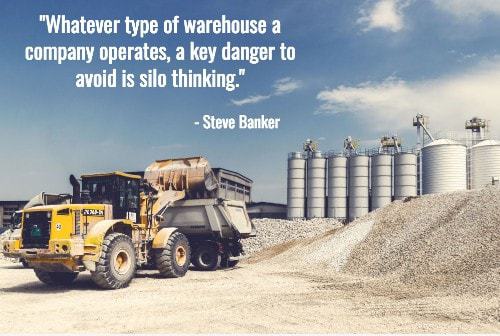
3. Consider the entire product supply chain to identify optimal points of automation. “Whatever type of warehouse a company operates, a key danger to avoid is silo thinking. If your upstream suppliers can perform certain activities more cost effectively than you can at your warehouse, then your partners should perform these tasks and you should pay them a little extra. Similarly, if performing certain tasks at your warehouse (for a marginal increase in labor costs) results in significant labor savings downstream (e.g., faster receiving and shelf replenishment at the stores), then those tasks should be done at your warehouse.” — Steve Banker, Automated vs. Manual Warehouses: A Different Way of Thinking About ROI, Logistics Viewpoints; Twitter: @logisticsviewpt
4. Ensure your system has cradle to grave traceability. “Increasing compliance requirements are putting more pressure on you to know exactly what components are used and where your products are at all times. How can you ensure safety of your end consumer if you are unaware of every step within your complex supply chain? The need for cradle to grave traceability from raw material through production will only keep increasing — save yourself the time and frustration by making traceability easier and more manageable.” — Robert Waugh, Best Warehouse Practices To Manage, Optimize And Execute Your Multifaceted Mfg. Operation, Industrial Distribution; Twitter: @Industwebsite
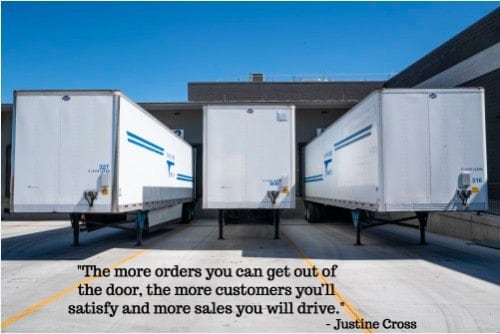
5. Use automation bots to free up valuable warehouse staff time. “Automation bots offer you and your team the chance to manage only by exception, thus, freeing up vital hours to be spent on the physical pick and pack stages. Ultimately, we know that the more orders you can get out of the door, the more customers you’ll satisfy and more sales you will drive.” — Justine Cross, Five Warehouse Automation and Technology Tips, ERP Focus; Twitter: @erpfocus
6. Automate where it makes sense – but understand the ROI. “Automation has become much more affordable the last decade or so in the face of just about everything else (labor, space, time) escalating. The idea of a robotic palletizer, automated stretchwrapper, or AS/RS system can be intimidating, but these methods are proven across every industry. For instance, robotic applications were once exclusive to manufacturing (in particular for welding in automotive manufacturing). Now, the same technologies are frequently applied – affordably – to distribution, picking, packing, etc. But you must understand the payback, not just the benefits.” — Scott Stone, 13 Best Practices for Warehouse Productivity, Cisco Eagle; Twitter: @CiscoEagle
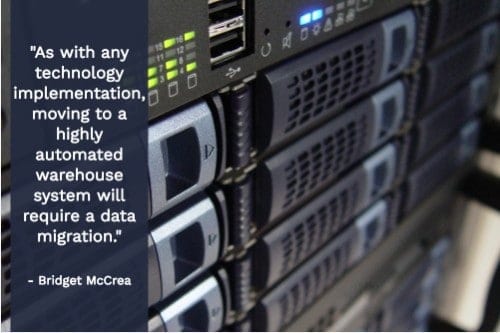
7. Don’t overlook the complexities of data migration. “If your company has been using a mix of manual and semi-automated systems to manage warehouse activities for decades, then it has likely racked up a good deal of data along the way. As with any technology implementation, moving to a highly automated warehouse system will require a data migration (i.e., the process of transferring data between storage types, formats or computer systems).” — Bridget McCrea, 7 Steps to Take Before You Install an Automated Warehouse System, Modern Materials Handling; Twitter: @modernmmhmag
8. Optimize your existing processes and identify areas of improvement prior to automation. “Examine the flow of product through the warehouse, traffic patterns, and overall layout of the facility. If you have not already done so, standardize your processes by reducing potential variation, which saves time and money, and reduces errors. Measure each activity in the warehouse to establish a baseline where improvements can be made. Once you know where to improve, determine how to make those improvements and identify a target metric to measure implemented improvements.” — Steve Adams and Steve Pierce, Considering the Costs of Warehouse Automation, Manufacturing Business Technology; Twitter: @MBTWebsite
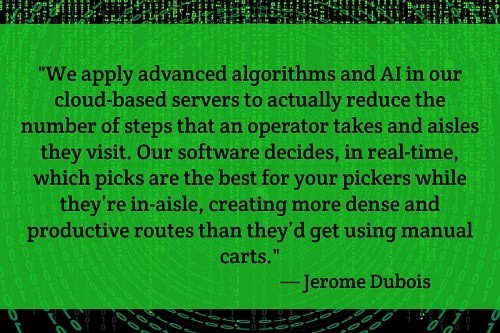
9. Implement solutions that reduce in-aisle steps. “In warehouses with manual carts, pickers spend a lot of time walking in between aisles in a mostly random fashion. At first glance, it may make sense, for example, to pick in FIFO (first in, first out) order, taking the first four pick lists from the stack at the wave prep desk. This leads operators to pick items for orders 1 through 4 in chronological order, often one order at a time, and possibly revisiting the same aisle or the very same location more than once. But what if orders 1,2, 8, and 10 have picks in the same aisle or even the same location? And what if the operator knew how many total items to pick for their cart at the location?
“That’s exactly what our software does. We call it smart work allocation. We apply advanced algorithms and AI in our cloud-based servers to actually reduce the number of steps that an operator takes and aisles they visit. Our software decides, in real-time, which picks are the best for your pickers while they’re in-aisle, creating more dense and productive routes than they’d get using manual carts.” — Jerome Dubois, How our software improves warehouse efficiency, 6 River Systems; Twitter: @6riversystems
10. Start small and build a scalable solution. “The path to advanced automation sometimes involves going through each level of automation sequentially as the business matures. When making the first upgrade decision, you should think ahead and pick an automation solution that is scalable and can be easily integrated with future solutions.” — Marco Trottman and Sam Zhang, The Trend Towards Warehouse Automation, Westernacher; Twitter: @Westernacher

11. Assign an individual or team to lead implementation. “The first step is to assign a specific person or team that will be responsible for handling the implementation and selecting the functionality that will be needed. This team should then be involved in all aspects of the planning and process creation. Companies that delay during this step may find themselves struggling to make a quick hiring decision and having the team trained and ready.” — David Allais, Automation in the Warehouse: Asset or Obstacle?, Industry Week; Twitter: @IndustryWeek
12. Engage outside experts to assess your warehouse layout. “Be open to the idea of getting expert advice. Warehouse design has changed a lot in recent years, as large distribution centers (DCs) have moved away from single channel to multichannel inventories and even smaller warehouses have begun to automate many operations.
“An experienced set of eyes can quickly scan your warehouse layout and spot signs of trouble, which can range from visible dust settled on products in storage (indicating obsolete inventory) to inefficient use of use of dock space (such as when put-away areas aren’t cleared out quickly enough).” — Cody Adams, 13 Tips for Your Ultimate Warehouse Design & Layout, Formaspace; Twitter: @RealFormaspace
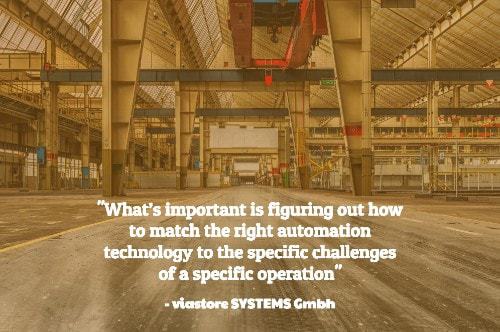
13. Match the automation technology to your specific operational challenges. “What’s important is figuring out how to match the right automation technology to the specific challenges of a specific operation, whether its goals are labor savings, space savings, throughput and flexibility gains, or reduced maintenance and supervision. Applying different automation technologies, either individually or in combination, can alleviate a variety of different challenges.” — 15 Myths About Warehouse Automation Debunked, Vlastore Systems; Twitter: @vlastoresystems
14. Conduct regular audits of your systems. “In addition to daily maintenance, it is recommended that you conduct an audit at least once every 12 months, regardless of the specific systems that you have in place in your operation. Doing so allows you to identify relatively minor issues (requiring minor repairs) before they turn into catastrophic issues (requiring major repairs, and downtime in your facility).” — The Supply Chain Professional’s Guide to Warehouse Automation, Conveyco; Twitter: @Conveyco

15. Improve security with unique password-protected access to all data points in your WMS. “Password-protect all data points in your warehouse management system. These may include areas like receiving, picking, packing, and shipping and loading areas. Use unique passwords and/or ID requirements.” — Best Practices for Creating a More Secure Warehouse, Carolina Handling; Twitter: @managesmarter
Shipping and Receiving Automation
16. Setup a system to pre-select shipment and delivery options based on the type of item. “Automatically select the service or carrier-based package weight, dimensions, delivery requirements or other criteria. This built-in logic ensures that only eligible services are considered, preventing users from choosing the wrong carrier, service or documentation.
“Example: A 14-ounce T-shirt order doesn’t need to be shipped using a service where rates are based on pounds and not ounces. Automating the shipping service selection allows your warehouse staff to focus on processing orders quicker and not rate shopping between carriers.” — 5 Great Tips to Automate Shipping Decisions in Your Warehouse, ShipWorks; Twitter: @shipworks
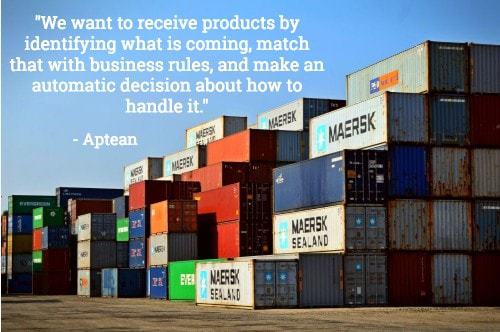
17. Identify data you could leverage to direct incoming shipments. “With a vision of highly automated warehouse processes, we want to receive products by identifying what is coming, match that with business rules, and make an (automatic) decision about how to handle it, where to put it, and if it needs to go through QA (Quality Assurance). Basically, you want as much information as possible to be known upfront – dimensions, packaging, origin, identifiers, descriptions, classifications etc. Provided that you can handle the data and make it available, it can trigger your defined business rules and direct available resources, pending orders and task priorities.” — A Smart Approach to Warehouse Automation, Aptean; Twitter: @Aptean
18. Don’t overlook boosting efficiency in your returns process. “Efficient returns handling is about more than just getting the goods that the customer doesn’t want/need back to the warehouse. By promptly and automatically linking your returns to your warehouse inventory, you will achieve more efficient and accurate order fulfillment. Once the stock becomes part of your inventory again it can be allocated to other customers who require those products.” — Addressing Warehouse Operational Challenges Through Warehouse Management Best Practices, TradeGecko; Twitter: @TradeGecko
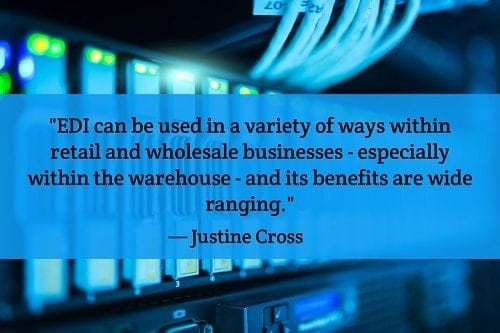
19. Leverage electronic data interchange (EDI) to reduce errors. “Electronic Data Interchange (EDI) is ‘the computer-to-computer exchange of documents in a standard electronic format between business partners.’
“EDI can be used in a variety of ways within retail and wholesale businesses – especially within the warehouse – and its benefits are wide ranging. Here are a few ways EDI can help you with your own warehouse processes:
- It prevents mispicks or incorrect items from being sent out
- It reduces the number of missed deliveries
- It can track, monitor and chase delays with suppliers
- It prevents double selling of your inventory
- It automatically sends tracking information to your customers” — Justine Cross, Five warehouse automation and technology tips, ERP Focus; Twitter: @ERPfocus
20. Install a high-speed, intelligent warehouse door system. “Modern automated warehouses are designed to be efficient. As one of the busiest working areas within any warehouse is the loading bay area, it makes sense that they are fitted with the best automation technologies available.” — Tony Saunders, Automation Tips for Warehouse Door Systems, Logistics Handling; Twitter: @LogHandling
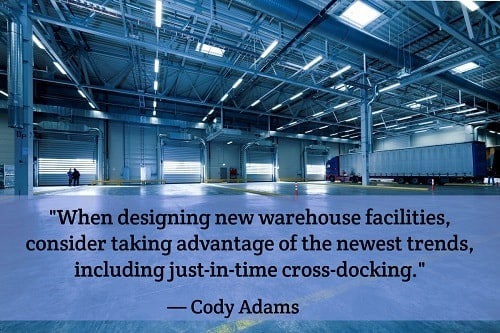
21. Focus your warehouse layout design decisions on the dock operations. “The dock area can be the most congested and potentially most dangerous area within your warehouse layout. When designing new warehouse facilities, consider taking advantage of the newest trends, including just-in-time cross-docking. Cross-docking is a technique where fresh inventory is unloaded directly from the inbound vehicle(s) then immediately re-loaded onto outbound vehicles — all without having to store the inventory in the warehouse. You’ll need to allocate additional space and multiple docks to perform these operations without creating choke points that impede flow.” — Cody Adams, 13 Tips for Your Ultimate Warehouse Design & Layout, Formaspace; Twitter: @RealFormaspace
22. Optimize the intake of stock with barcode scanners or other automation equipment. “Invest in barcode scanners or other automation equipment that will interface with your WMS. This will significantly increase throughput as manual descriptions and item numbers will not have to be read out and checked off.” — A.J. Brustein, Tips to Optimize Your Warehouse Management System and Staffing, Wonolo; Twitter: @Wonolo
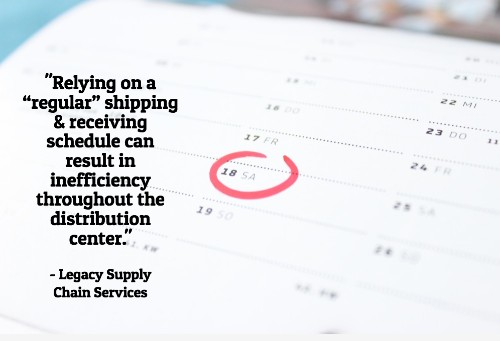
23. Establish advanced shipping notifications (ASN). “This may seem like a no-brainer, but many distribution centers still have not implemented electronically transmitted advanced shipping notifications (ASN). Relying on a ‘regular’ shipping & receiving schedule can result in inefficiency throughout the distribution center.”— 11 Warehouse and Distribution Center Best Practices for Your Supply Chain, Legacy Supply Chain Services; Twitter: @legacyscs
Tips for Automated Collaboration
24. Consider labor management tools to optimize performance. “Labor management software can help you gain control of these costs and enable you to visualize, understand, and take command of the labor situation as it really is, not as you think it is. Handling labor resources correctly can be the difference between an adequate operation and a good one…or a good one vs. a great one. These tools are best applied in high-volume picks, not for bulk items where heavy machinery is required to deal with stock.” — Scott Stone, 13 Best Practices for Warehouse Productivity, Cisco Eagle; Twitter: @Ciscoeagle

25. Minimize the number of steps in the order fulfillment process. “Another area that can be problematic for many companies is that the number of steps it takes to fulfill orders is so lengthy and complicated that employees can’t remember them easily. Any process with more than a handful of steps is open to mistakes. Spend some time in the warehouse working alongside your team to actually see what’s working and what doesn’t. Then update the process, reducing redundant steps and making it simple and effective.”— 4 Warehouse Management Tips to Reduce Fulfillment Errors, Scanco; Twitter: @scancollc
26. Establish standards and monitoring of workforce requirements. “New methods and labor processes are required that are more event and customer driven than ever before. A key requirement is to plan, schedule, and automate the deployments of staff to match needs in a dynamic real-time picking and shipping environment.”— Bob Heaney, Warehouse Workforce Scheduling and Management Across Tasks, Waves, and Shifts, JDA Software Group; Twitter: @jdasoftware
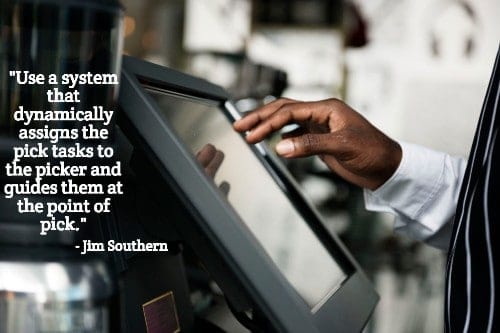
27. Don’t preallocate stock to orders. “Many traditional ERP and WMS systems ‘allocate’ stock in locations to orders. This assumes you are going to pick the orders in a particular sequence, which in reality doesn’t happen. Using this method a picker may arrive at a location, see the stock, but not be able to pick it because it’s not allocated to their order — which is crazy! Use a system that dynamically assigns the pick tasks to the picker and guides them at the point of pick. This will save time on travel and replenishments.” — Jim Southern, 5 Tips on How to Improve Order Picking, Dexterity; Twitter: @dexteritywms
28. Implement solutions that provide a directed workflow. “Once pickers get in-aisle, they run into another efficiency problem: picking the right items into the right totes. In an entirely manual situation, pickers are juggling a lot. They are rarely hands-free because they need to handle an RF gun, a paper pick list and push a manual cart. They need to identify which bin the pick is located in, and they need to make sure they’re picking the right item into the right tote.
“With our software, the robot stops exactly where the pick is located, displays a picture of the item on a screen and lights up on the left or right, indicating which side of the aisle the pick is located in. The software also powers the put-to-light technology, which shows pickers which totes to place items into.” — Jerome Dubois, How our software improves warehouse efficiency, 6 River Systems; Twitter: @6riversystems
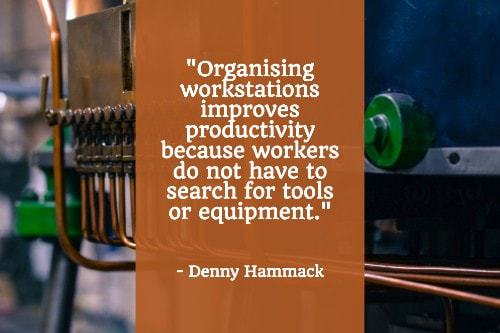
29. Organize workstations using lean manufacturing principles for a streamlined workflow. “Organizing workstations improves productivity because workers do not have to search for tools or equipment. Use the ‘5S’ method from lean manufacturing to ensure your workstations are as organised as possible. It consists of: Sort; Set in order; Shine; Standardize; and Sustain — all techniques designed to keep clutter at bay, reduce errors and improve safety and organisation.” — Denny Hammock, Five Simple Ways to Improve Warehouse Efficiency, Supply Management; Twitter: @supplymgmt
30. Utilize a Workflow Execution System (WES) to help synchronize operations between human workers and your automated systems. “In addition to rationalizing order feed control, the WES enabled operators to adapt to the fluctuations in workflow as well. They were given screens that would reveal bottlenecks so they could shift dynamically. The system could also be configured to provide voice alerts directing them to log out of low-load zones and move an overloaded zone. The result was a 20% improvement in productivity in an operation that the warehouse manager had believed was already operating at peak efficiency.” — Chris Capshaw, Warehouse Execution Systems Can Unlock the Potential of Automation Assets, Material Handling and Logistics; Twitter: @MHLeditor
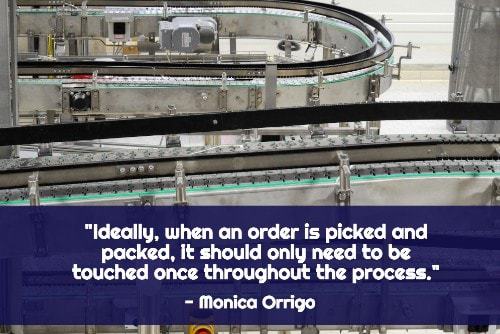
31. Minimize touches in your pick and pack processes. “Ideally, when an order is picked and packed, it should only need to be touched once throughout the process. To accomplish this, the order must be error-free and packed correctly the first time, moving directly from shelf to box to truck without having to be moved in and out of totes or repacked into smaller or larger containers. Minimizing this kind of rework helps make the picking and packing process more efficient.” — Monica Orrigo, How to Drive more Efficiency From Your Pick and Pack Process, Handshake; Twitter: @Handshake
Tips for Inventory Management and Fulfillment Automation
32. Use WMS to improve your warehouse storage capacity. “When you implement warehouse management software, you may find that you could have been fitting more product onto your shelves! The WMS assigns every product a specific location and bin number in the warehouse, based on the size of the bins and the amount of product kept in inventory. The lesser used inventory is often assigned to higher shelves or in out-of-the-way places within the warehouse, while the more popular items can be kept on lower shelves and near the shipping area. This approach maximizes the use of your warehouse shelves and allows you to be more efficient within your allotted space.” — Reid Curley, 6 Ways Automating Warehouse Systems Makes a Huge Impact, Archon Interactive; Twitter: @WaveTrak
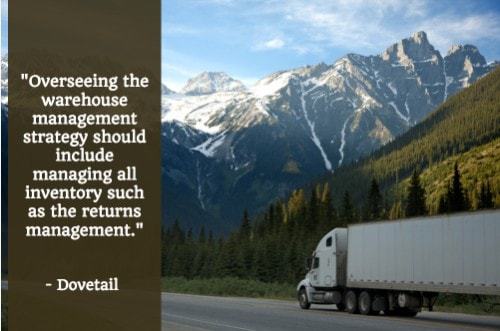
33. Manage all inventory flows, including returns. “Overseeing the warehouse management strategy should include managing all inventory such as the returns management. Returns may mean there’s a problem with a certain product, however, warehouse managers can utilize this as an opportunity to fix and fine-tune existing warehouse stock and ordering practices.”— 8 Principles That Establish A Cost Efficient Warehouse Management Strategy, Dovetail; Twitter: @DovetailSA
34. An autonomous warehouse vehicle may help with inventory movement. “When specifying automated warehouse vehicles, remember to ‘always keep the most important thing as the most important thing,’ which, in any MHP, is the product being handled or transported. There are many types of AGVS vehicles, but, no matter how advanced a particular AGVS may be, if its vehicle cannot transport the thing that needs to go from A to B, it is useless.” — Adam Cole, Navigating the World of Automated Warehouse Vehicles, Bastian Solutions; Twitter: @BastianSolution

35. Select boxes, bins and shelving solutions that are automation-friendly. “From storage containers to overall floor plan, strategic warehouse design enables the latest in automation. Boxes and bins are designed in an automation-friendly way so robots and AVGs can move them freely throughout the facility. It’s the same with shelving and racks. Shelves are being built to be more mobile and conducive to the latest in automation trends. These designs enable a more organized and efficient workspace.” — Cary Frame, 4 Top Trends in Warehouse Automation, Hynes Industries
36. Anticipate business drivers that may impact inventory levels. “Speak with your sales and marketing areas to understand when promotions are happening that may result in increased demand. Look at seasonal trends to understand busier times and ensure you have proper staffing levels across the rota. Plan this in your WMS.” — A.J. Brustein, Tips to Optimize Your Warehouse Management System and Staffing, Wonolo; Twitter: @Wonolo
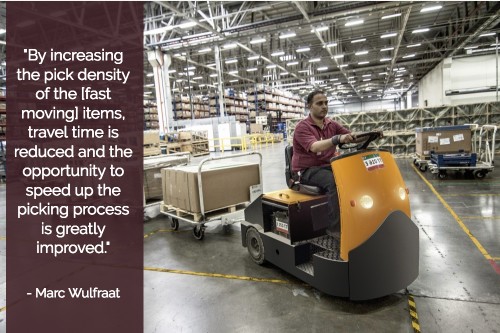
37. Set up hot zones in the warehouse to concentrate the SKUs that generate the majority of picking activity. “Some warehouse operations have ABC velocity definitions so that the fastest moving ‘A’ SKUs are positioned together within designated wider operating aisles to reduce congestion. By increasing the pick density of the ‘A’ items, travel time is reduced and the opportunity to speed up the picking process is greatly improved.”—Marc Wulfraat, 5 Ways to Improve Order Picking Productivity, Supply Chain 24/7; Twitter: @SupplyChain247
38. Utilize RFID tags to streamline the warehouse picking process. “There are numerous steps merchants can take to improve the efficiency of the warehouse picking process, but one of the leading strategies is the implementation of RFID tags. This technology enables merchants to track items throughout the picking process, check them in and out automatically, bolster visibility across the warehouse and combine multiple orders effectively.”— Optimize your Picking Process using RFID Technology, SalesWarp; Twitter: @SalesWarp

39. Set a baseline to measure improvements. “You may have heard from employees that there are ‘many’ mistakes being made in the shipping process. Just how many mistakes qualify as ‘many?’ Whenever you can, quantify the situation and set a baseline so that you will know for certain whether improvements you make are having the desired effect.” — 4 Warehouse Management Tips to Reduce Fulfillment Errors, Scanco; Twitter: @ScancoLLC
40. Plan your order packing workflow by examining potential errors at each stage of the process. “Plan out the error correction sequence in advance. Make sure there is enough physical space at the shipping station to set aside the incorrect materials and replace them with the corrected ones. This includes provisioning enough space to make the correction; for example, there might need to be space on the shipping table for two boxes at the same time, the incorrect one and the corrected one.”— 10 Speedy Shipping Station Setup Tips, Formaspace; Twitter: @RealFormaspace
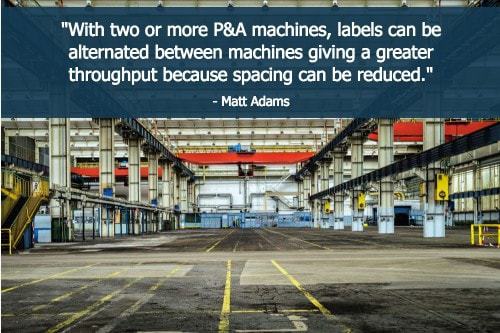
41. Spacing is a key consideration when using a print & apply (P&A) automated labeling system. “Consistent gapping (spacing between product) should be created to allow time to print and tamp; otherwise, the product could travel past the P&A machine(s) before a label is ready to be applied. The gap will we defined by the print speed of the chosen printer and cycle time of the tamp head. These variables will also help determine the speed of the conveyor. The smallest box height is what will take the longest for the tamp motion if using an overhead apply system.
“To improve throughput, multiple P&A units can be installed. With two or more P&A machines, labels can be alternated between machines giving a greater throughput because spacing can be reduced.”— Matt Adams, 10 Tips for Setting Up a Label Print and Apply System, Bastian Solutions; Twitter: @BastianSolution
42. Use collaborative robots to improve fulfillment speed and accuracy. “At 6 River Systems, we developed Chuck, a mobile warehouse robot that is designed to help today’s warehouses make the most out of the labor they already have. In the past, warehouses had to rely on machines, such as conveyors, automated storage and retrieval systems and shuttles, to eliminate walking and shorten fulfillment times. However, those solutions are often bulky and less versatile compared to modern alternatives.
“Because of this, we created an ultra-flexible line of collaborative robots that swiftly move across your warehouse floor, speeding up the picking rate by roughly 2-3x. Using a directed workflow approach, our collaborative robots pace your associates to help them quickly move through all the steps in the picking process, and our cloud-based software intelligently groups similar orders together to boost efficiency. Plus, Chuck works with your desired picking method, whether it’s wave, batch, zone, discrete, cluster or a combination of methods.” — Fergal Glynn, What is automated warehouse picking?, 6 River Systems; Twitter: @6riversystems

43. Make sure spare parts are available and accessible. “Availability of spare parts is a common problem for owners of automated systems. Consider what items may already be on hand or in your network and what time it takes to acquire the part when ordered from the manufacturers. A parts crib (i.e., a secure, well-maintained area to warehouse your spares) is a reliable and deliberate way to receive, inspect and log parts.” — Michael Koteki as quoted in 8 Practices in MRO for Automation, Logistics Management; Twitter: @LogisticsMgmt
44. Start small by implementing a cluster-picking strategy. “By picking into multiple order containers (e.g., totes containing order batches or discrete order totes), companies can effectively pick multiple orders at one time using a single cart. And, make sure that cart is sizable (i.e., 5 feet x 2 feet with at least two or three shelves) and able to handle the multiple orders.” — Bridget McClea, 7 Warehouse E-commerce Best Practices for 2017, Modern Materials Handling; Twitter: @modernmmhmag
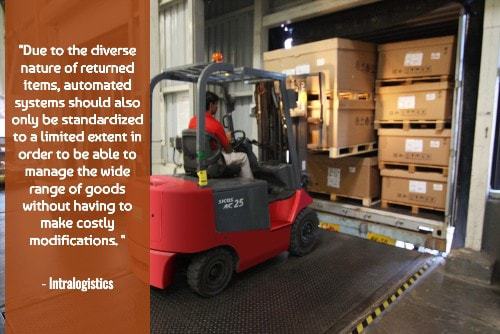
45. Balance automation with manual processes in your returns process to maximize efficiency. “Due to the diverse nature of returned items, automated systems should also only be standardized to a limited extent in order to be able to manage the wide range of goods without having to make costly modifications. In contrast to conventional storage and returns strategies, which are often associated with a very high level of manual work, automated processing requires much higher investment in technology and software.” — Managing Returns Fully Automatically – the Ideal and the Reality, Intralogistics
Logistics Automation Examples and Fleet Automation Tips
46. Utilize routing and scheduling software to streamline logistics planning. “Automation is a great benefit of logistics technology — though not the only one. Technologies that automate time-consuming, repetitive jobs free us up to do what humans excel at: spotting and dealing with change and exceptions.” — Mike Kositzky, Automated Routing: The Path to Optimization, Inbound Logistics, @ILMagazine
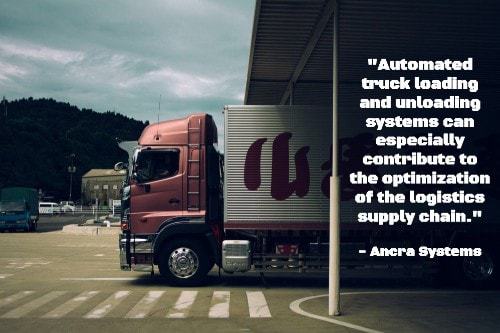
47. Automated Truck Loading Systems (ATLS) can greatly reduce logistics handling time. “Automated truck loading and unloading systems can especially contribute to the optimization of the logistics supply chain with a fast return on investment in applications with high volumes and short driving times.” — Technology Information: Automated Truck Loading Systems, Ancra Systems
48. GPS technology can allow tracking of your inventory on the road and in the warehouse. “Many conventional inventory tracking systems note the location of your inventory within the warehouse upon arrival. However, if the pallet or box is later moved to a different location, it can easily become lost or misplaced. GPS tracking ensures this doesn’t become a problem.” — Megan Webb Morgan, 3 Tips for Tracking Inventory with GPS, Manufacturing Transportation, Apriso; Twitter: @3dsdelmia
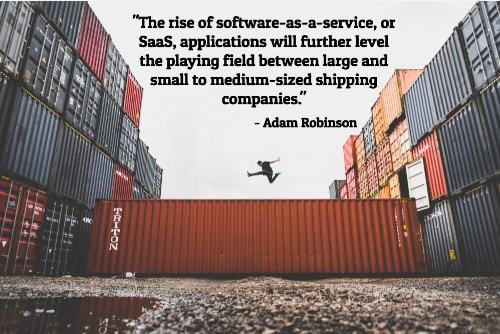
49. Transportation Management Systems (TMS) are more widely accessible. “Historically, shippers were unable to take advantage of a TMS unless the shipper processed an extraordinarily high volume of shipments. For many smaller shippers, utilizing a TMS was simply out of the question. However, the rise of the cloud has changed that. The rise of software-as-a-service, or SaaS, applications will further level the playing field between large and small to medium-sized shipping companies.” — Adam Robinson, 3 Logistics Technology Trends in 2016: Automation Leads the Way, Cerasis; Twitter: @Cerasis
50. Omni-channel distribution centers can simplify order picking and reverse logistics. “Use omni-channel distribution centers rather than separate warehouses or sections for each channel. You will be able to reduce the total inventory in your supply chain, have greater visibility into availability, and simplify order picking and reverse logistics.” — Top 11 Warehouse Operations Best Practices, Westfalia Technologies; Twitter: @WesfaliaUSA
The post 50 expert warehouse automation tips and best practices appeared first on 6 River Systems.
]]>The post What is automated warehouse picking? appeared first on 6 River Systems.
]]>Automated warehouse picking is a collaborative effort, and it’s not just reserved for major enterprises with seemingly unlimited budgets. The best solutions can be tailor-made to add value to your existing picking processes, without the need for months of downtime or a years-long wait to achieve ROI.
Definition of automated warehouse picking
Automated warehouse picking is the implementation of robotic or semi-robotic technologies that enhance the work of human pickers. Though there is a wide range of options to choose from in the realm of automated warehouse picking, the most efficient automation tools work with your team members and can be easily integrated into existing warehouse processes quickly and seamlessly.
Automated warehouse picking can also reduce walking time and shorten picking routes, integrate with your existing WMS and support accurate picking and packing. It can be used in a broad spectrum of industries, including e-commerce, manufacturing, retail, transportation, food and beverage, medical equipment and more.
How automated warehouse picking works
As mentioned, there are all sorts of automated warehouse order picking systems on the market today, but the best kind is the one that focuses on collaboration between the picker and the robot, not the kind that aims for complete substitution.
At 6 River Systems, we developed Chuck, a mobile warehouse robot that is designed to help today’s warehouses make the most out of the labor they already have. In the past, warehouses had to rely on machines, such as conveyors, automated storage and retrieval systems and shuttles, to eliminate walking and shorten fulfillment times. However, those solutions are often bulky and less versatile compared to modern alternatives.
Because of this, we created an ultra-flexible line of collaborative robots that swiftly move across your warehouse floor, speeding up the picking rate by roughly 2-3x. Using a directed workflow approach, our collaborative robots pace your associates to help them quickly move through all the steps in the picking process, and our cloud-based software intelligently groups similar orders together to boost efficiency. Plus, Chuck works with your desired picking method, whether it’s wave, batch, zone, discrete, cluster or a combination of methods.
In short, automated warehouse picking includes the same integral steps of traditional picking methods, but without the risk of human error, slowdowns and inefficient tracking.
Benefits of automated warehouse picking
We’ve already touched on some of the benefits that come with implementing an automated warehouse picking solution, but let’s delve even deeper into how impactful the change can be for all types of warehouse operations.
- Super-fast productivity: As mentioned, mobile automated warehouse picking technologies are best known for decreasing pick times. In fact, most warehouses see their picking speeds pick up by roughly 2-3x. This is because collaborative robots are able to move across the warehouse floor faster than their human counterparts. And more importantly, they can keep going all day long, without the need for breaks or shift changes.
- Easy-to-learn: One of the best design points of Chuck is the system can be learned in a matter of minutes. This means that pickers don’t need to undergo rigorous training to begin collaborating with their high-tech counterparts.
- Safety: Robot technology meets both OSHA and ANSI standards. Relying on sensor technology, they adhere to rigorous stop accuracy and can easily navigate around humans and equipment. And because collaborative robots move on their own, they create a hands-free picking environment for operators. These benefits support a safer work environment, reducing the likelihood of on-the-job accidents and injuries for your warehouse staff.
- Flexibility: Traditional warehouse automation systems are bulky, consuming a lot of valuable warehouse space. Plus, they’re anchored in place, making it difficult to modify your warehouse layout. On the other hand, modern warehouse automation tools like collaborative robots offer a customizable approach, with flexible rental pricing to help warehouses accommodate seasonal demand.
- Rapid implementation: One of the key money-savers that go along with an automated warehouse picking investment is that the technology requires zero new infrastructure to begin working. In fact, most warehouses can start reaping the benefits of their new system within roughly 2-6 weeks.
- Scalability: In the past, accommodating peak seasonal demands with traditional approaches meant sizing an automation solution around a few months of demand. But loading your building with heavy equipment that won’t be used for most of the year isn’t the most efficient use of capital for many companies. Collaborative robots, on the other hand, can be added as needed and quickly give you incremental capacity. That means you can rent additional capacity during peak seasons or even relocate robots to other facilities should needs shift across your network of distribution and fulfillment centers.
- Adapts to your current WMS: In addition to working with your existing physical infrastructure, collaborative robots don’t require any overhauls on the IT side. In many cases, collaborative mobile robots come with software that enhances your existing WMS or WES.
- Low investment: Although your automated warehouse picking solution will very much be a prominent player in your facility, it costs less than you might think. In fact, this technology has a price tag that is one fifth that of traditional warehouse automation tools.
- Reliability: With traditional warehouse automation solutions such as conveyors, warehouse operators are putting all their eggs in one basket. They need to be able to depend on their systems to get orders fulfilled, and if a conveyor system goes down, it can bring an entire warehouse operation to a halt. But if a single collaborative mobile robot goes down, there’s no impact on throughput or operation, as other robots can simply pick up the slack.
Clearly, collaborative robots are a good fit for warehouses that want to strengthen accuracy, promote efficiency and modernize features, all without making a risky investment or making substantial changes to physical infrastructure.
The post What is automated warehouse picking? appeared first on 6 River Systems.
]]>The post What is a Pick to Light System? appeared first on 6 River Systems.
]]>What is Pick to Light Technology?
Pick to light is a type of order-fulfillment technology designed to improve picking accuracy and efficiency, while simultaneously lowering your labor costs. Notably, pick to light is paperless; it employs alphanumeric displays and buttons at storage locations, to guide your employees in light-aided manual picking, putting, sorting, and assembling.
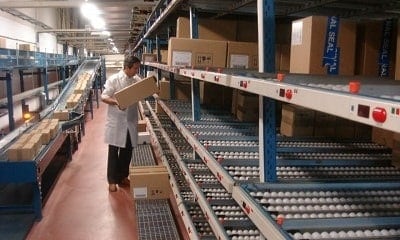
What is a pick to light system? It’s a promise of more streamlined warehouse operations.
How Does Pick to Light Work?
There are small variations in pick-to-light systems in a warehouse, but the standard technology works like this:
- Operators scan item barcodes that are attached to temporary and reusable holding containers, for example, shipping cartons.
- The system’s alphanumeric display (usually, LED lights) then lights up, illuminating a path to guide the operator to the indicated storage location. There, the system then indicates how many and which items should be picked.
- The operator picks the item(s), places them in the holding container, and then presses a button to confirm the picking.
- The system continues in this way, illuminating each sector for picking until all items have been picked and placed in their respective holding containers.
Depending on the pick-to-light system, additional options may be available. Often, in addition to the LED display, pick to light also offers an acknowledgment button and a digital readout, to enable more detailed instructions and options. For example, your chosen system may allow employees to record basic data, such as variations in pick size; other systems could detail special instructions, order numbers, zone directions, and additional information.
What is the Difference Between Pick to Light and Put to Light?
Put to light is essentially the inverse of a pick-to-light system: simply reverse the flow, and a put-to-light system will guide operators to organize incoming goods in a retail store, grouped as a customer order, or in any other organizational method.
Both pick-to-light and put-to-light systems work best at high densities. They provide a better return on investment in high density areas because the units are being moved more often, its quicker for the operator to identify the right item due to the clear lighting system.
Warehousing Applications of Pick to Light
There are many pick-to-light applications, each of which depends on various factors, such as the size of your warehouse and order sizes. How you use your system will depend on your warehouse and business, but there are a few common applications, for example:
- Component picking, for example in kit assembly
- Carousel light towers
- Full case picking, from pallet flow
- Etcetera, etcetera
What Are the Benefits of Pick to Light?
As far as warehousing operations go, pick-to-light systems are an excellent tool for increasing productivity and efficiency, as well as for reducing picking errors. But, of course, there’s more to the pick-to-light process than that:
Ease of Use
Training operators in traditional picking can take hours – or more, depending on the size and complexity of your warehouse. With an efficient pick-to-light system, you can cut training down to 30-45 minutes. (Talk about nearly instant gratification!)
System Integration
You can install a standalone pick-to-light system, of course, but depending on your warehousing needs, you can also integrate pick to light with an existing warehouse management system (WMS), enterprise resource planning (ERP), supply chain management, or other host systems, for better warehouse controls.
Furthermore, more advanced pick-to-light systems can produce pick-rate reports, analyze productivity and other metrics, and also allow for variance in the size of work zones, to account for labor-to-order volume needs.
Increased Efficiency
Pick-to-light systems are usually organized by your existing work zones, which helps minimize walking – and, therefore, boosts efficiency. Additionally, if an order is required to pass through multiple work zones, your pick-to-light system follows the order, helping reduce idle time.
You can even mount some pick-to-light systems onto mobile carts or conveyor systems, allowing a single operator to fulfill an entire order, through many zones of your warehouse.
It’s Paperless
Tied to the benefit of increased efficiency, it’s important to note the benefits of a paperless picking system. In short: Your operators save time when they eliminate the step of leafing through paper-based records.
Improved Order Accuracy
From a customer-service standpoint, the greatest benefit to pick-to-light systems is fewer picking errors. Pick to light helps boost order fulfillment performance, which in turn nets happier end customers.
Lower Labor Costs
Traditional order picking methods add up to one of the biggest expenses in warehouse operations. But, when you implement systems for less walking, shorter time to order fulfillment, greater order accuracy – all these factors lead to one major benefit to your warehouse: reduced labor costs.
This a natural result of greater productivity and efficiency, but it’s one very worth noting. Your pick-to-light system can easily pay for itself.
Now, you know: pick-to-light systems offer big advantages to warehouses, both big and small. Now, you tell us: Do you already use a pick-to-light system? If you don’t, why not?
Interested in more? Let’s discuss the solution that’s right for you. Contact us today.
The post What is a Pick to Light System? appeared first on 6 River Systems.
]]>